The Sheer Joy and Utter Agony of Running Your First Pro Race While Possibly Dying
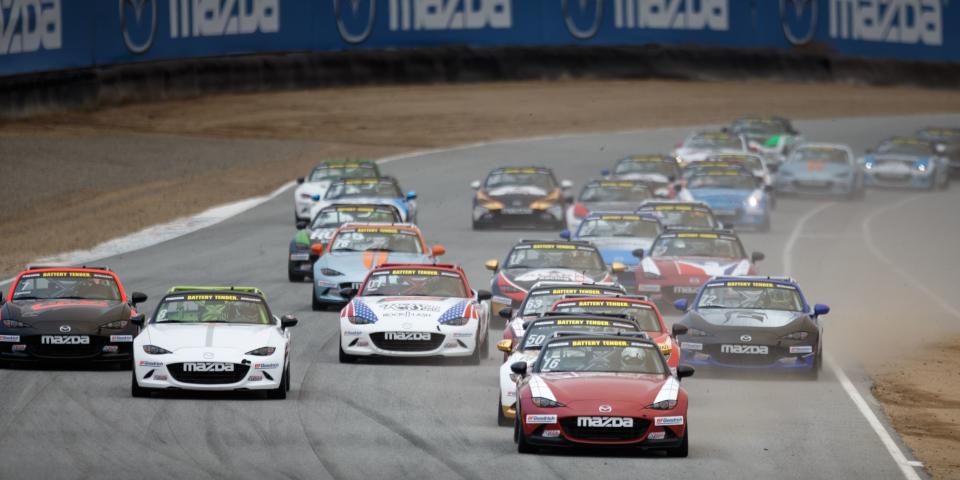
TEN YEARS AGO, MAZDA RACEWAY LAGUNA SECA hosted the first-ever round of a North American spec series called the MX-5 Cup. The brainchild of a senior Mazda executive and club racer, the series used the NC-chassis (2006-2015) Miata in basic race trim, with improved suspension, a roll cage, better brakes, and a complement of safety gear. It was pegged off the SCCA's exceptional Spec Miata classes, which were designed to expose driver talent on an affordable playing field.
Cup races were held at professional sports-car races across the country. This spring, the series was revamped to use the ND-chassis (2016 and on) MX-5. Each car costs $53,000-pennies for a professional road-racing rig-and uses a sealed 155-hp driveline. An arrive-and-drive package for the 12-race season is around $100,000. Nowhere else can you run with the big boys and have so much fun for so cheap.
The first round of the new championship was held at Laguna Seca in April. On a week's notice, Mazda invited R&T editor-at-large and amateur club racer Sam Smith to take one of the 40 grid slots. They provided the car, waived damage cost, and told him to go like hell.
The fun part: Smith was in the middle of a monthlong bout of severe illness. He'd never started a pro race. He hadn't raced a modern car in years. And he wasn't given any test time-crucial in a spec series. The weekend consisted of two 45-minute sprint races, plus practice and qualifying time.
It went well.
No, not really. Not at all, in fact. Also, there was a lot of puking.
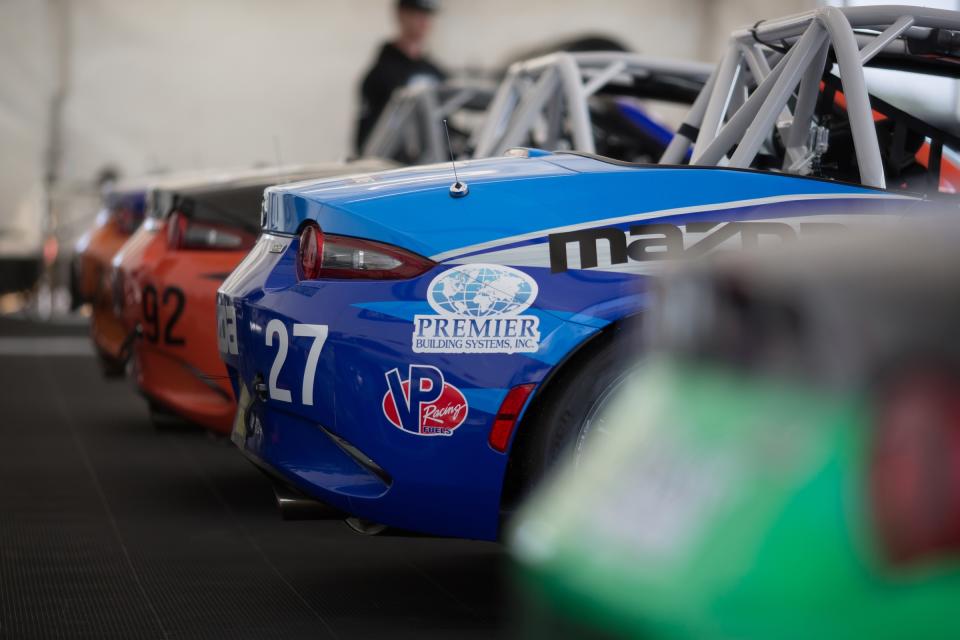
Prologue: An Inconvenient Truth
The invite to drive the Mazda comes one week before the race. Come, they say. Race our car, no fee if you damage it, just go out and try as hard as you can.
I am at R&T's home office in Michigan, thousands of miles from my home in Seattle. I have what appears to be the end of the world's worst case of bronchitis. It turns out to be the beginning. I spend five days with my body rejecting everything. I cough so hard I bruise two ribs. I can't sleep. Food makes me sweat. Sleeping makes me sweat. Nothing stays in my body unless accompanied by industrial-strength DayQuil. There is a fever, which breaks, only to be replaced a day later with another fever. Then another fever after that.
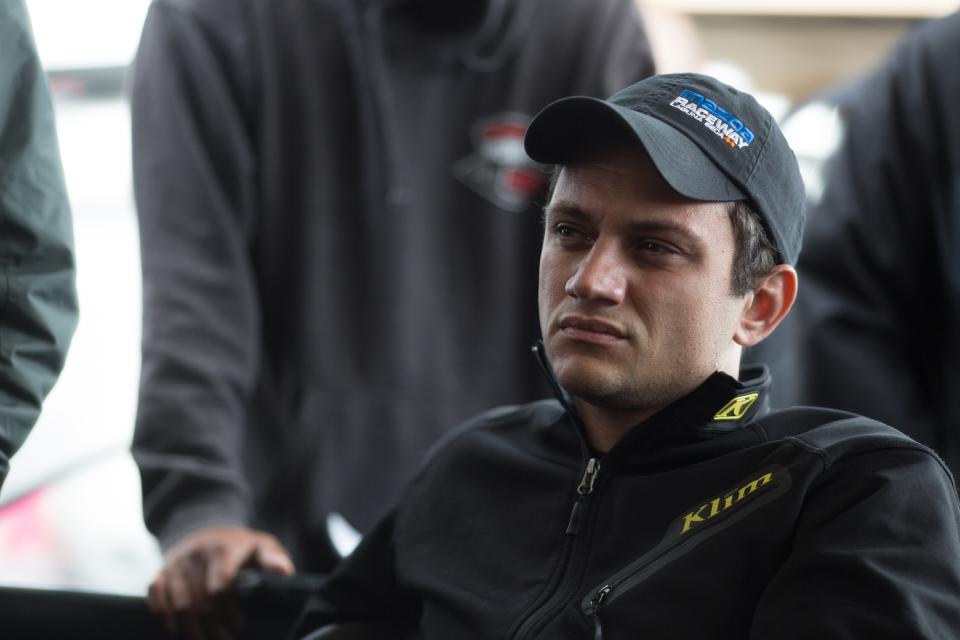
Instead of resting, I chase prior commitments and pretend to be healthy. I go to a dirt-bike school in Nevada. I drive to Watkins Glen for an endurance race. At the Glen, I climb into a race car for a two-hour driving stint. I make it seven laps before pulling into the pits, apologizing to my team, and quietly vomiting into a trash can.
Naturally, three days later, I fly to Mazda Raceway Laguna Seca, in California. On the airplane, I accidentally cough on my seatmate, an older man in nice clothes. I try to apologize, but he waves me off with a polite smile and gets up to go to the lavatory.
When he comes back, he smells like hand soap.
Lots of hand soap.
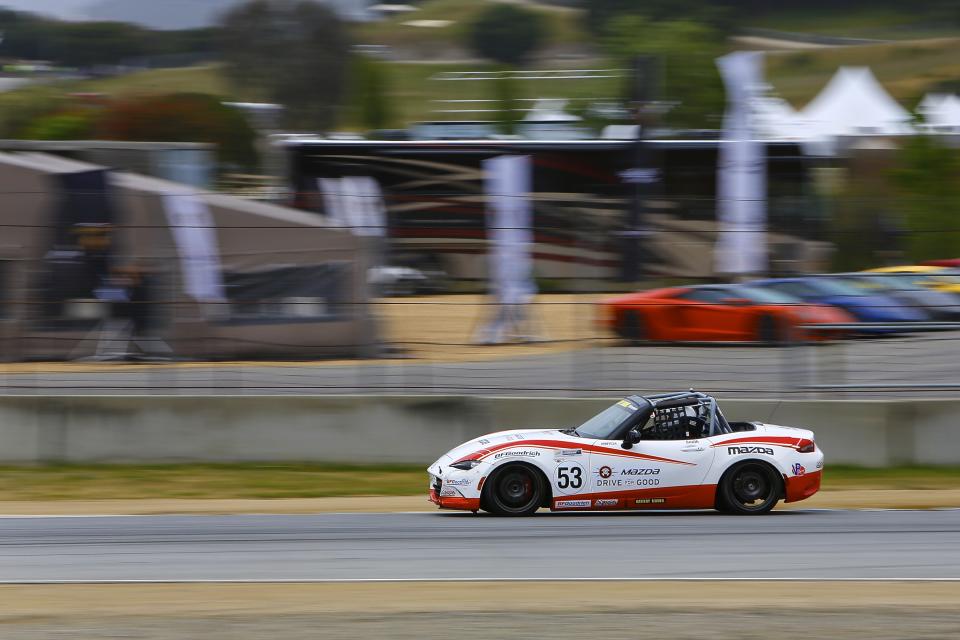
The First Practice Session: Or, Death in the Morning
My eyes don't focus. My voice is an octave below normal. I drink a cup of coffee and meet my car. White with red streaks, like my face. Everyone on the Mazda factory team-a superb outfit called Long Road Racing, out of North Carolina-is nice, probably because they cannot see inside my head. It feels like that scene in Men in Black, where the dude's face opens up and there's a tiny alien in a chair, running his body. I can't decide if I'm the tiny alien or the body.
I sit in the car. I've never seen an MX-5 Cup car before, so there's a walkaround. "These are the diff and transmission cooling pumps. That's the fire button. You're short, have a seat pad." I drive through the paddock, toward the false grid, for practice. They wave the field onto the track.
A wash of recognition: Laguna! I know Laguna! I've been here before!
And then it goes to hot garbage.
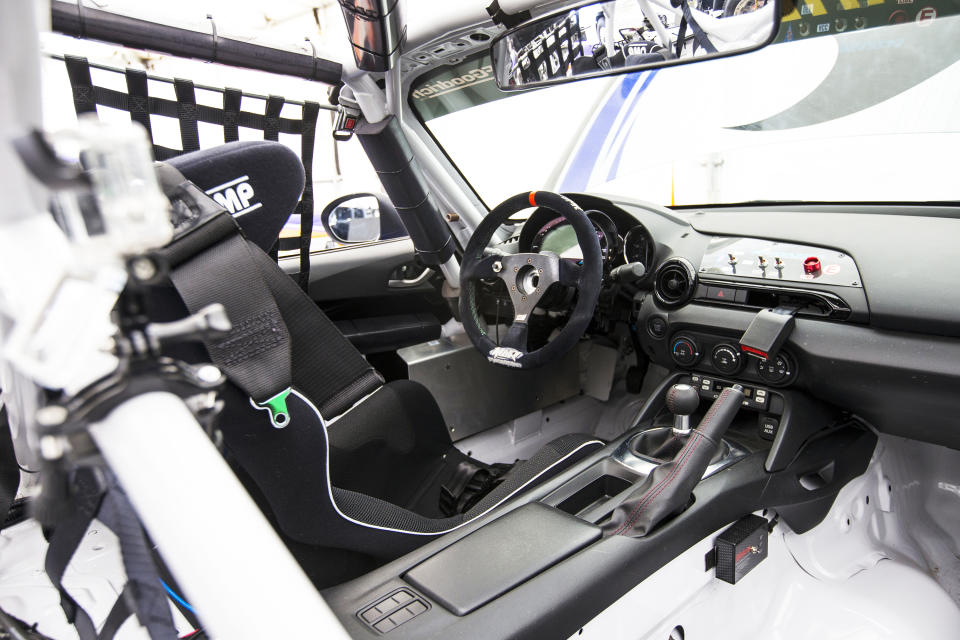
Most of Laguna's corner curbing has a giant concrete bump at the apex. It's meant to keep people from driving too far inside-if you hit it, your car launches into the air. My vision is blurry, and in the first lap, I probably sky off those curbs five or six times. Whack and a jump and God knows what it does to the alignment and you land half-sideways.
Two laps in, I'm exhausted. I can tell by the car's responses that the tires, grippy as greased rocks, are unhappy. With 10 minutes left to go, the crew brings me in to check tire pressures. Back on track, I watch other cars avoid me in what seems like obvious fashion.
I'm a decent club racer-I've won races, flirted with track records. I know what I'm doing wrong, I just can't make my body do what's right. How do you look through the corner when each of your eyes is in a different zip code? How do you have smooth hands when you can barely keep your head off your chest?
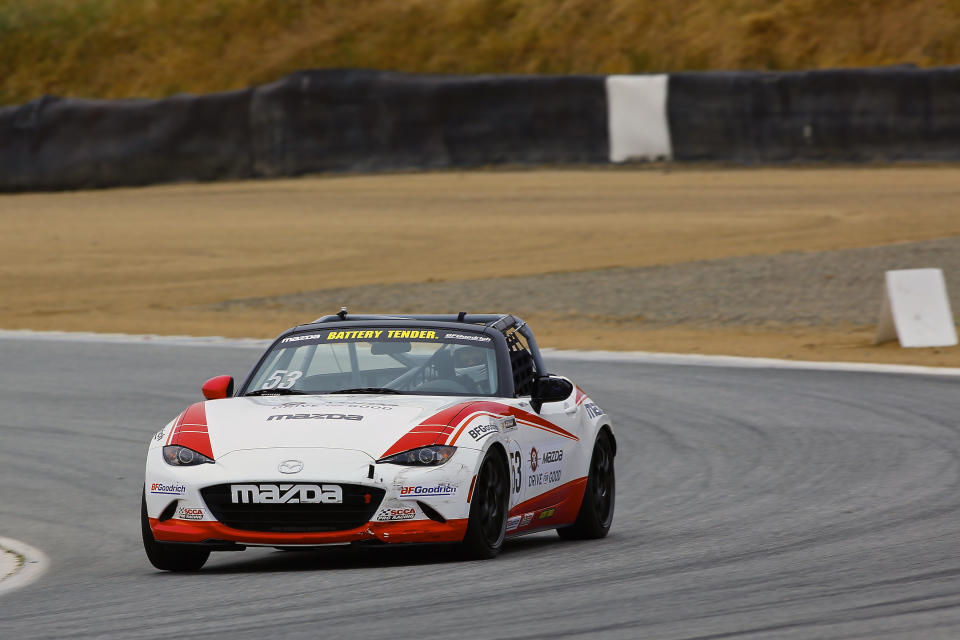
How do you look through the corner when each of your eyes is in a different zip code?
The real shame is the MX-5-it's a sweetheart, and I'm doing it zero justice. A marvelous street car made into a friendly, approachable race car. A Spec Miata with more honed suspension, better tires, real and usable power. The car's fastest when it's sliding, but it doesn't park itself with a bit of yaw. The Long Road guys have given me a slightly loose setup-neutral, with quick turn-in, but the back end wags if you get sloppy.
I hit a coughing jag in Turn 4. My arms send the car loose, a small, snatchy slide that would normally be easy to catch. I can't stay with it and am gifted with one of those big, slow-motion spins. Who spins a Miata?
The Mazda goes in the dirt ass-first. No bent sheet metal, but a few tire scuffs on the front bumper.
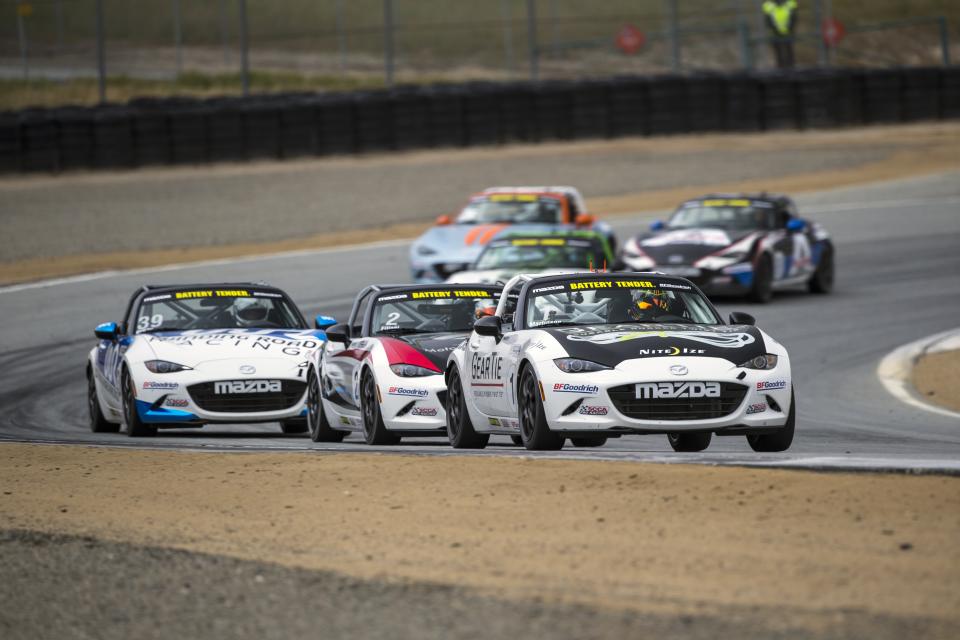
Back in the paddock, I fall into the couch in Long Road's trailer. Dean Case, Mazda's motorsport PR rep, walks in. "You are seeking sponsorship from Robitussin," he says. I attempt to laugh, then cough, then almost fall off the couch from coughing-that whee whee whistle-wheeze when your lungs give up.
An older gentleman enters the trailer. White hair, SCCA Pro Racing hat and jacket. I know the face-have known it for years-but can't place it. He introduces himself, in a southern accent: Terry Earwood. Chief steward, MX-5 Cup.
Terry Earwood! Firehawk series career wins leader! Skip Barber Racing School chief instructor for 26 years! I am briefly starstruck. Because I am a dork, I inform Terry Earwood that I am a fan. He pauses for a moment, face blank, as if no one has ever told him this. Raised eyebrows.
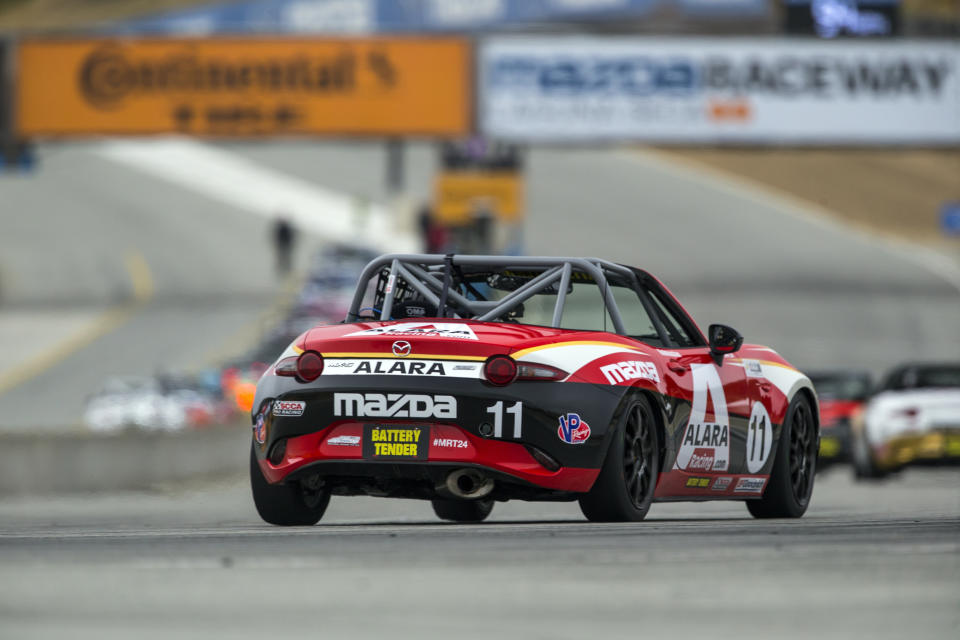
"What on earth is going on?"
Terry Earwood is here to ask why I am being an asshat in a race car. I want to evaporate.
"It's been proven, you know, that the right foot is the human male's dumbest appendage."
I cough again. Terry asks if I'm sick. I apologize and say yes. Terry asks me if I know what's going wrong. Yes, I say, embarrassed.
Another sigh. Earwood heads out, but not before giving a benediction: Back it down a little.
Terry Earwood probably thinks that I shouldn't be driving. I would listen to Terry Earwood tell me anything. But what amateur racer wouldn't kill for a weekend in this series? What do sick pros do?
I lie down in the trailer for five minutes, thinking about the complications of good luck. Then I stumble to the restroom and throw up breakfast, just like James Hunt.
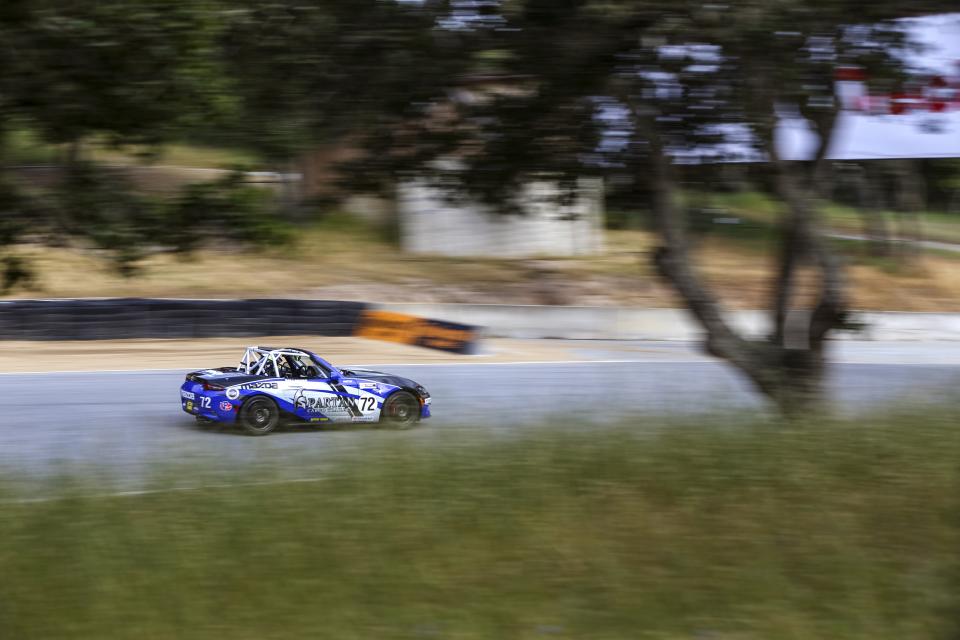
The Second Practice Session: Dying Twice In One Day
Being part of a pro race is weird. A paddock full of legitimate cars and prototypes and serious iron next to mom-and-pop teams in the Mazda series. Between fits of hard-core napping, I wander the paddock. Chip Ganassi's Ford GTs are there, in addition to Mazda's Le Mans prototypes, Pratt & Miller Corvettes, and an entire field of sedans and sports cars competing in the Continental Tire SportsCar Challenge.
A friend later noted that access is the great peripheral benefit of running in the MX-5 Cup. Everyone knows you can go pro racing if you find the right team and write a big check. The glory lies in the scale: Moneywise, MX-5 Cup racing is the equivalent of being allowed to dance in a Super Bowl halftime show because you bought out the hotdog cart.
On the way back to my car, I run into Glenn Long, one of Long Road's principals. I cough, then apologize, almost as a reflex.
"What are you sorry for? You get sick on purpose?"
"Somebody's got to take responsibility?"
"Skinny dipping has its pros and cons." He chuckles. "Just remember to drink plenty of liquids, because drinking solids sucks."
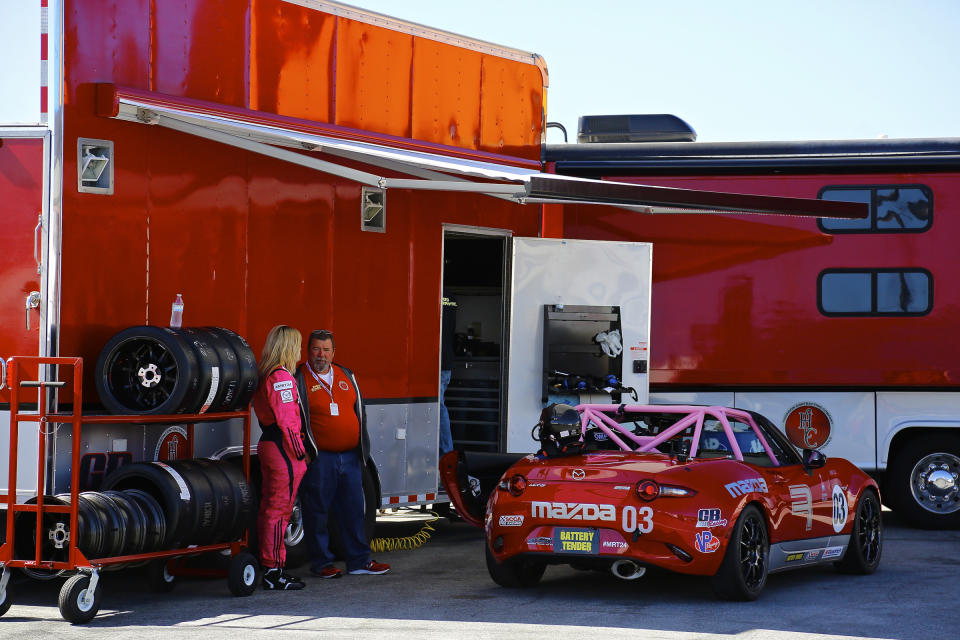
Time to go out again. I slam three steaming-hot cups of coffee, then belt into the car. Improvement. I can at least run with traffic, but I'm still making dumb mistakes. The car slides too little, then too much. The overdose of caffeine produces a ghostly, predictive voice in my head, not unlike a helpful fortune teller, if said fortune teller were a total dick.
You're going to slide the car too much! You are a jackhole! Go back to a sport for kittens! Knitting! Crochet! Puppy cuddling!
I overuse the tires, brake too much, make a hundred tiny errors. It adds up to a big chunk of time. I'm 33rd out of 40 cars, an eternity behind the leaders. The only consolation: I've never seen the car before today, and everyone else here has tested for hours.
R&T's Jack Baruth once wrote that disappointment is the only thing that makes racing worthwhile. This may be true, but from the bottom of a grid sheet, it's as comforting as a punch in the colon. I go to bed at an hour usually reserved for toddlers, feeling extremely worthwhiled in myself.
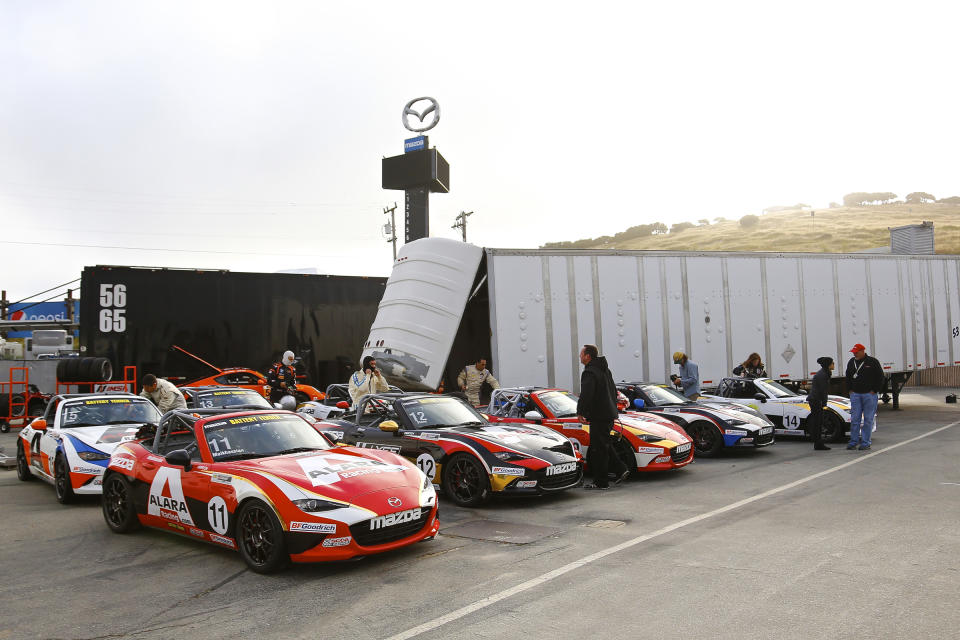
Qualifying: Redemption, Albeit Briefly
Dean Case tries to make me feel better. "You know, we've put pros in these things before-big names with lots of experience. They don't always do well. The cars take some getting used to."
It's counterintuitive, but the ND Cup car doesn't work like a Spec Miata. You spend most of your time with your right foot on the floor-speed comes on corner entry-but that and a general balance are all the two have in common. The Cup takes more work to go quickly, requires more delicacy at the limit, especially in off-camber corners like Laguna's Turn 9.
Road racing is mostly finesse, and my hands feel like numb lumps of meat.
Something happens in qualifying. Things start to click. Road racing is mostly finesse, and my hands feel like numb lumps of meat. But I find myself using more of the pavement, the car running more freely. Actual delicacy is probably out of the question, so on the straights, I try to will my fingers into being tinier lumps of meat.
On the qualifying chart, I settle into 30th place before my body gives out. I can't move my legs quickly enough to properly blip the throttle on downshifts. Sometimes it works, sometimes it's a blugh! and a jerk and the car lurches into gear.
As I park the car, Kenton Koch, the Cup's 21-year-old series coach and a Daytona 24-hour winner, walks over.
"That was good! Don't be so hard on yourself. This is your third session in the car. Most of these guys have been doing this, in cars like these, for years."
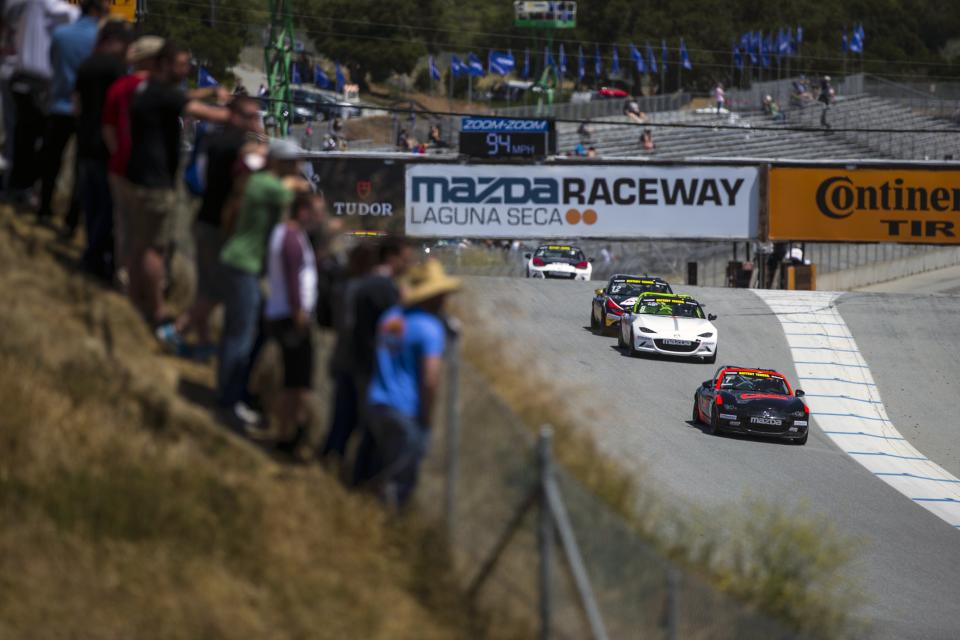
I thank him and unclick my belts. I grab the roll cage with one arm, trip on my way out, and end up hanging upside-down like a monkey, one leg trapped in the car. Somewhere, Roger Penske gets indigestion.
That voice in my head, now chipper: Pro racing! How did you get here? How cool is this?
I have a brief moment where I wish that voice were a real person, so I could hug it. And then punch it in the face.
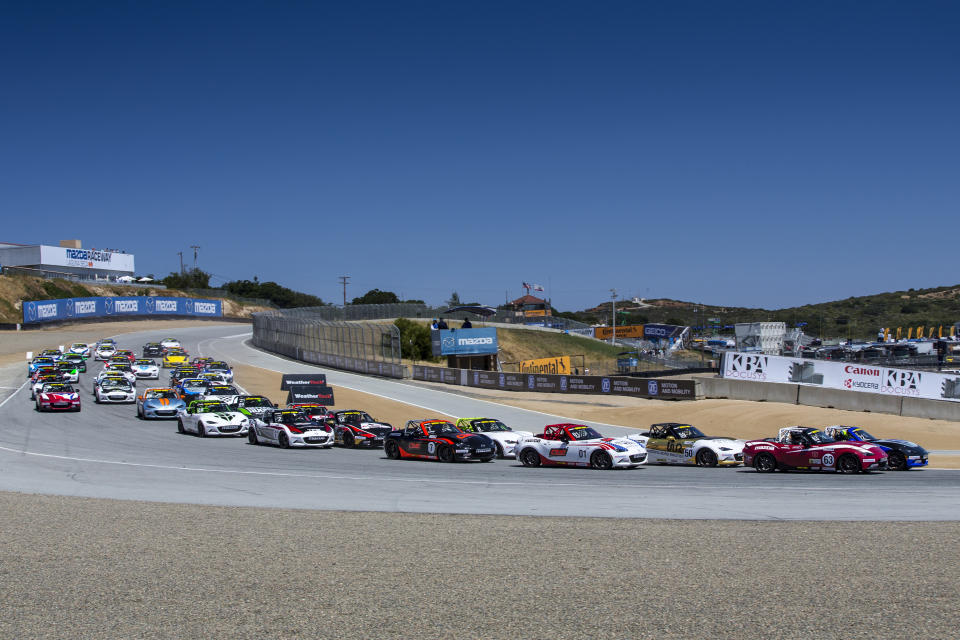
Race One: He Lived to See It
Friday afternoon. I start 30th out of 40. Cars run three and four wide on the entry to Turn 1. The gap between 40th and 20th place is a shave of tenths. Twenty cars packed into a heartbeat.
Coming into Turn 2, I nip around and pick up a few places. On the entry to three, feeling brave, I dive under two nose-to-tail cars. They turn into the corner, both headed for my left flank. I can hit them or drive half of my car into the dirt.
"Screw it," I think, "wheel in the dirt." I miscalculate, and then I'm further into the dirt, and even further, and then somebody taps me in the rear bumper, and the Mazda spits sideways, and I come out of the dirt big sideways and am flung into the dirt on the other side of the track.
Stuck.
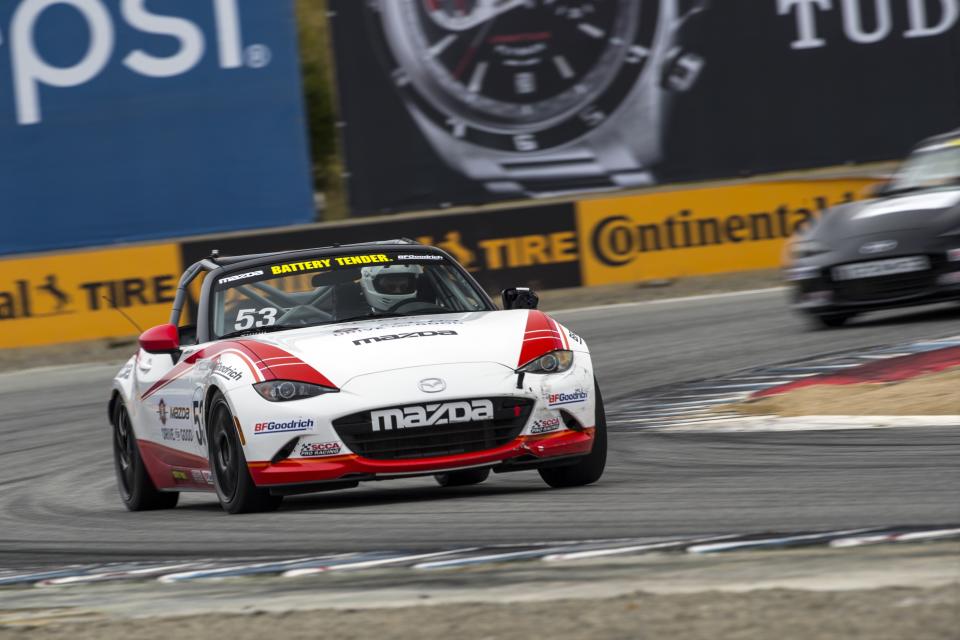
Huge dust cloud. Rear wheels buried in sand, the field droning off into the distance. That voice, back again: What, did you think they were going to leave the door open forever?
With nothing else to do, I try drive out of the sand-a little throttle, rock the wheels, repeat. Ten seconds later, I'm back on asphalt. Dirt flies out of the footwells. I drive around for 40 minutes, catching traffic but getting lapped by the leaders until the end of the race. A hole forms in the bottom of my stomach: a whole race, wasted.
On the plus side, back in the paddock, I feel healthy enough to loosen my belts and climb out of the car without falling over! The glow of momentary success straightened my spine, propping me up like a pair of crutches.
Then I go into the bathroom and puke again.
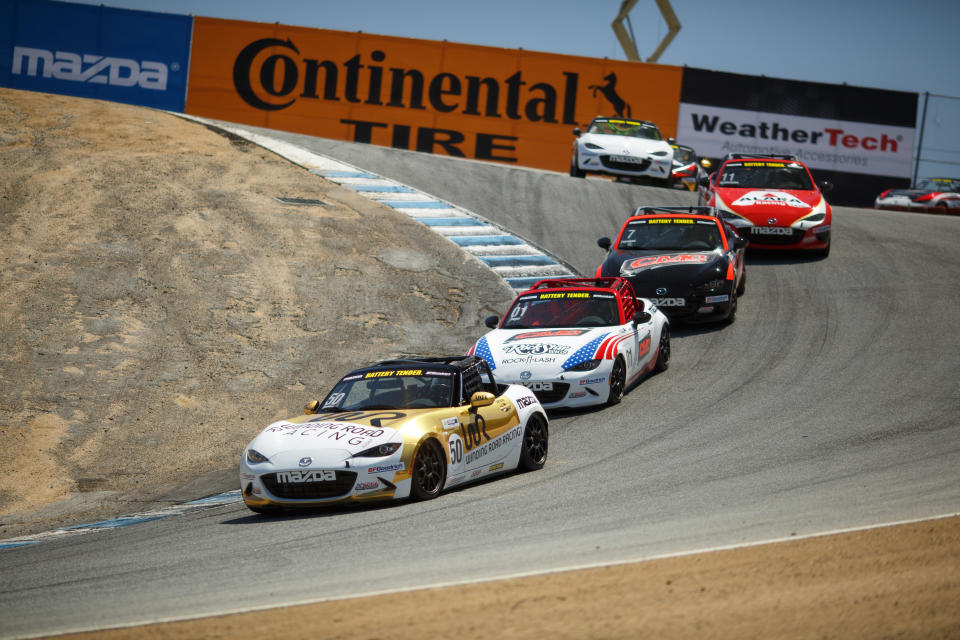
Race Two: Of Course It Ended Badly
"Sam, I'm in a 4:30 meeting on a Friday. Remember that you're driving a race car, and thus having a great day no matter what." -Travis Okulski, editor, RoadandTrack.com
"You didn't massively f*** up or f*** anyone else up. So, um, good job? I'm sorry, I'm stretching here." -Dan Smith, father of the author, via phone after the first race
"Hey, look! You didn't break the windshield!" -Jay Chapman, crew, Long Road Racing
The second race is on Saturday. I wake up that morning feeling normal. In retrospect, the symptoms were probably akin to a serious hangover. After three weeks of crippling illness, it felt like a gift.
Leaving my hotel, I text Travis Okulski, the editor of this website. He tells me that the TV announcers were impressed that I didn't get stuck in the dirt on Friday. I decide that it's good to be known for something. The start is mayhem, a greater mess than the first race, probably because everyone knows they have time to fix their cars before the next round, weeks from now, and don't have another race to make it through tomorrow.
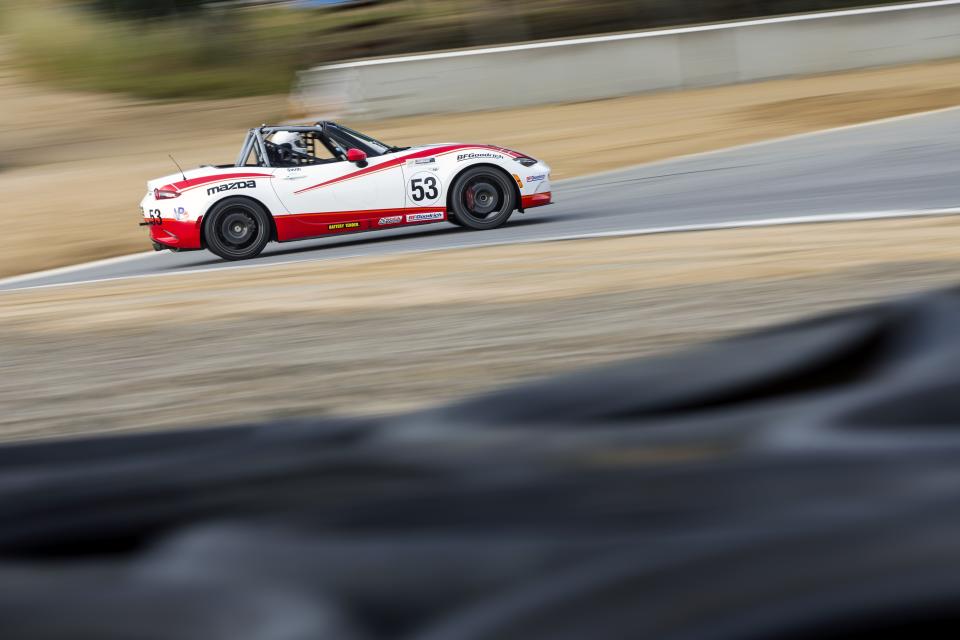
Cars get hit. Cars go off. And then it settles out, a train of Miatas, each one sniffing the bumper of the one in front. That little feeling where a race car is just skittering on turn-in, slip in the tires, everything equal. The noise when you're running the car right and it's up on the pipe and making the right snarl in faster corners. The breathe-turn-THWACK-run-up-the-hill joy of Laguna's Turn 6, where the car just magically finds the exit if you do it right. That moment in traffic where you get a run off a corner and end up almost buried in someone's bumper, but you lift a micron so you don't slam into their trunk and just train up the hill.
Did I mention that the MX-5 Cup is good racing?
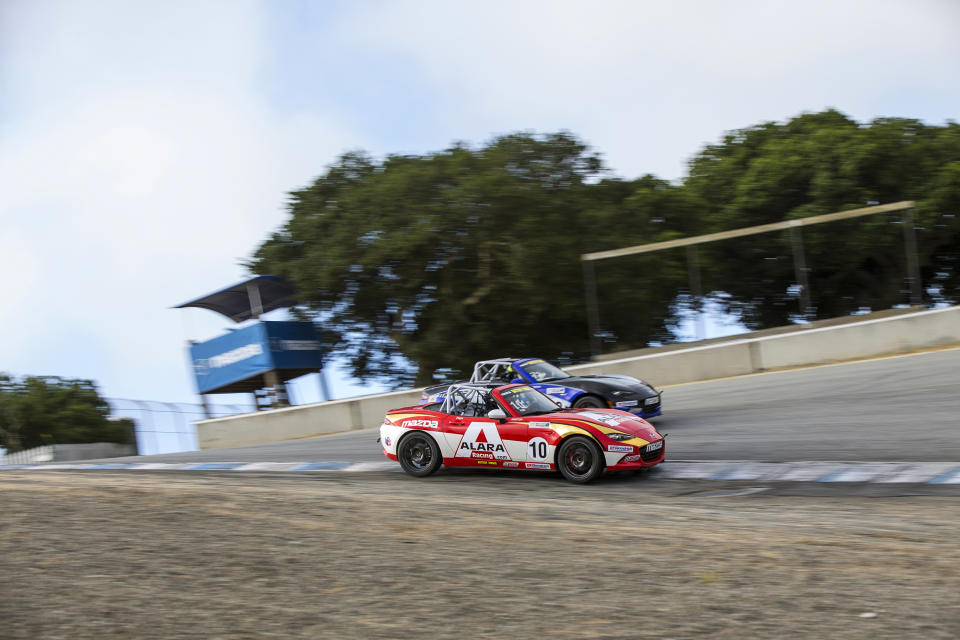
And then I boff it. While half the field crashes into itself, I keep my nose clean for five laps, claw out several passes, then go looking to make up time. At which point I come into Turn 6 slightly too hot and sideways. I catch the slide but run out of pavement, the Mazda careening up the track's steepest hill. A sand mound horse-kicks the car backward into a tire wall.
Again, I drive back to the pits. Again, I park the car, only this time, there is a race going on, and I'm not in it.
I sling off my helmet and watch. What a thing. Lead changes hot and heavy. Diabolical passes. From the first lap to the checker, you could have covered the first six cars with a blanket. The win goes to a gutsy 19-year-old from New Jersey named Robby Foley-he pulls off a gorgeous pass in the race's final throes, fourth to first.
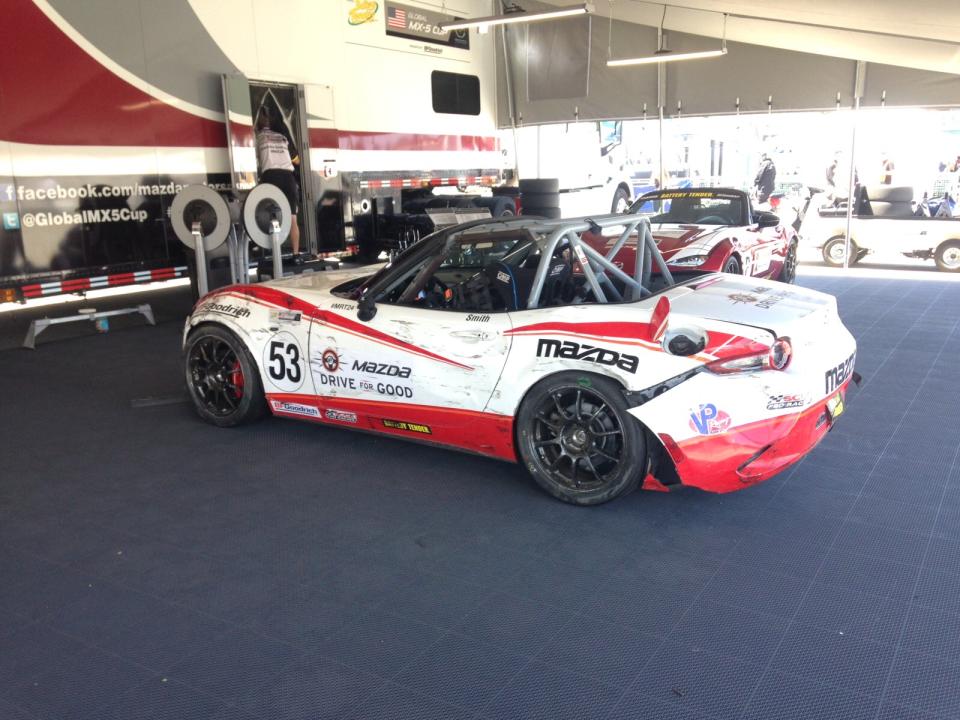
After the race, I wander into the media center and find R&T correspondent Marshall Pruett. He's talking to John Krewson, a former R&T senior editor.
"Those first laps were some of the worst collective driving I've ever seen," Pruett says. "And you!" He looked at me. "You're a mobile Pininfarina!"
"Huh?"
"Restyling your car on the fly!"
Krewson and I walk out of the media center. I look at Krewson, slightly put out. "He called me a mobile Pininfarina!"
He glances over, deadpan. "Well, I mean, they're a very good design house."
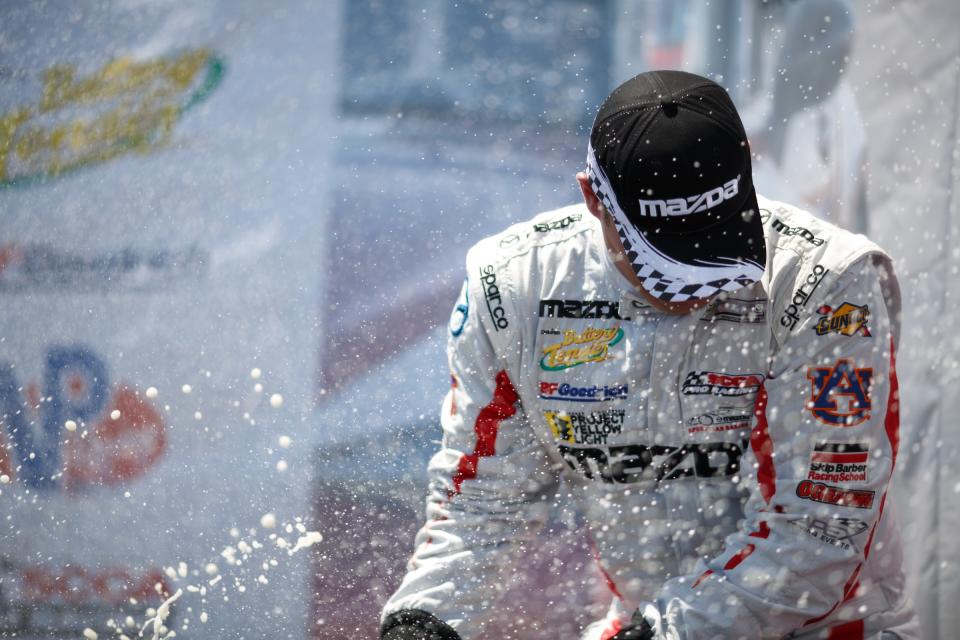
Epilogue: And the Vomiting Stops
The former editor of this magazine, a man named Larry Webster, competed in the first MX-5 Cup race, at Laguna, 10 years ago. Larry left the magazine a few months ago, but when he was here, we spent a lot of time at tracks together. In similar cars, on an empty track, we usually lapped within tenths of each other.
Larry finished fourth in that first Cup race. At Laguna, I text him about that. "I got lucky," he says.
I doubt that; Larry's good, and a better racer than I am, better under pressure. But that's the interesting thing about competition, in any form: There are no prizes for beating yourself up and endless opportunities to do it. We all believe that we're exceptional in some way. Everyone thinks that they'll pull through and be the hero when the chips are down. Sometimes you can. Sometimes you have a direct and unassailable metric with which to measure how 29 other people were simply better.
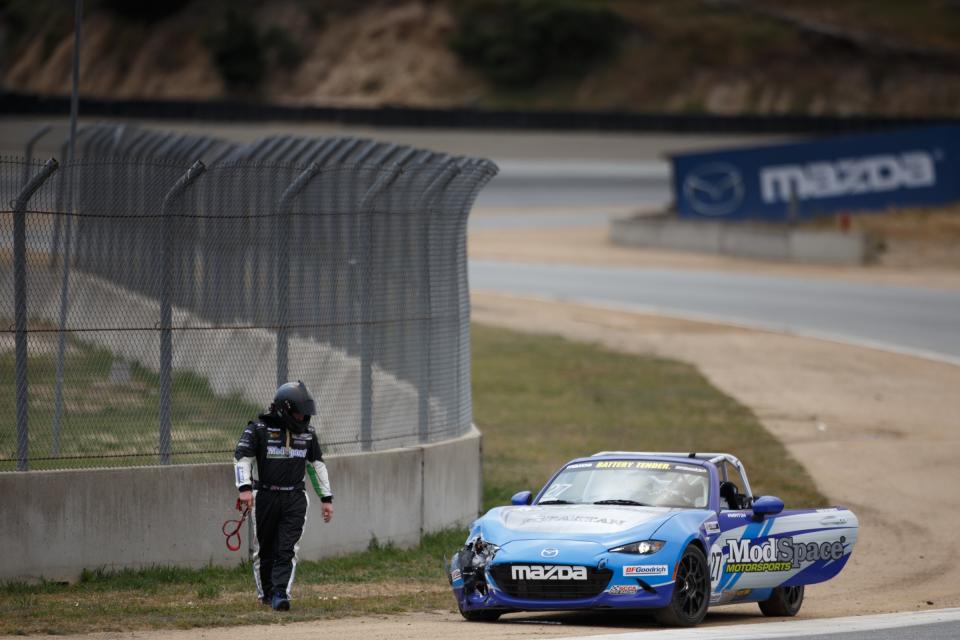
Everyone thinks that they'll pull through and be the hero when the chips are down.
But calculated risks are what make any racing worth it. Far as I can tell, if you're a professional, you're supposed to have a sharper risk barometer. And when you screw up, it feels different-there's more at stake. But it's also more of a business, so you have to move on. It's both easier and harder to deal with on a number of levels.
And ultimately a choice. You can elect to not race at all, or worse, drive around at the back of the field and risk nothing. Or you can bash the fenders off your car and treat every lap like your last. The correct answer varies, but you can't pretend emotion doesn't sway.
And if I'm being honest, damn if I didn't want to start a pro race more than I wanted to be sick as hell. Even if it was the wrong call.
Weird moment, right? I had no idea how much being sick would change me as a driver; I'd never met that circumstantial intersection, so I had no barometer for it. And I ultimately made a choice about my limits-flying in the face of feeling like death-that I can't say I'd make again. But if racing isn't about learning from choices, then I don't know what is.
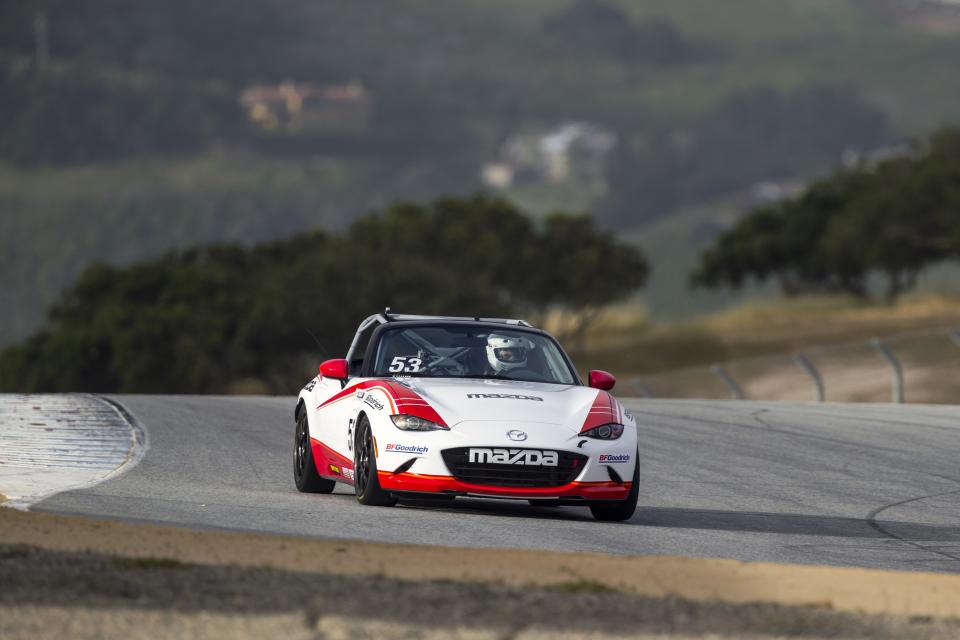
The evening after the second race, I relapse. It all hits me like a train: dry cough, wheezing, weakness, cold sweats. It took five days in bed to kill the bronchitis and a dose of antibiotics to fix the balance and fever problems.
A week after the antibiotics ran their course, safe at home, I was talking to a friend on the phone. Not a car person, not a racer, just a buddy from the rest of my life. After I relayed what happened at Laguna, he said, "Man, I'm surprised you didn't drive into a wall more. I wouldn't have done that in a million years. Did you even have fun?"
I thought for a minute and looked at the phone. I briefly wondered if anyone had ever asked Ayrton Senna that.
"Are you kidding?"

 Yahoo Autos
Yahoo Autos 